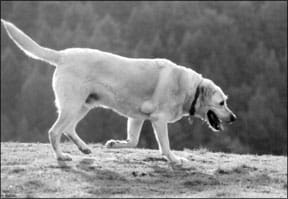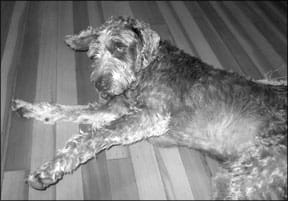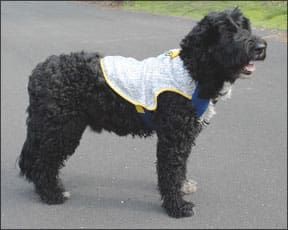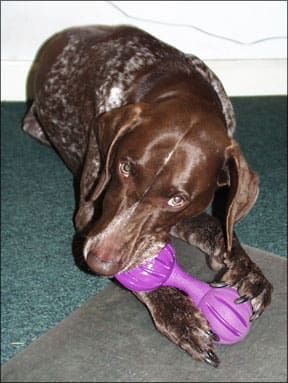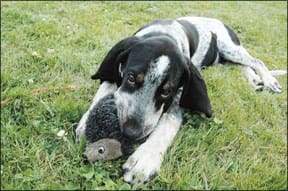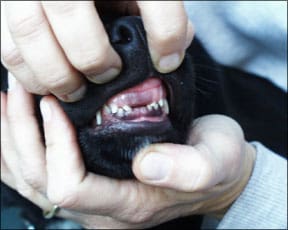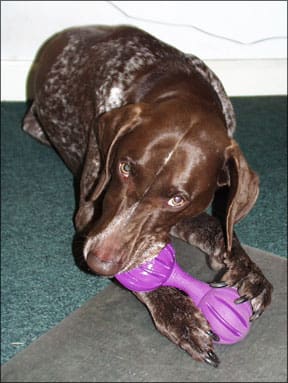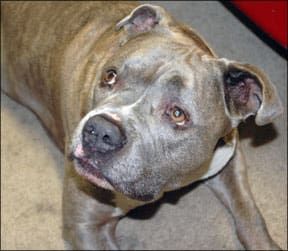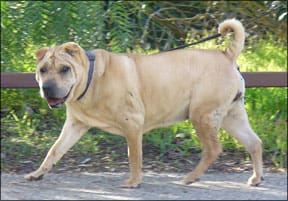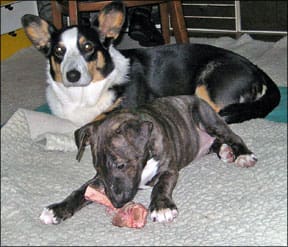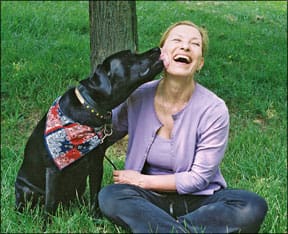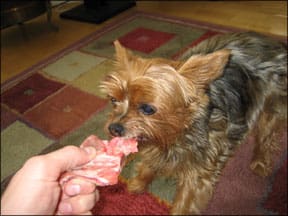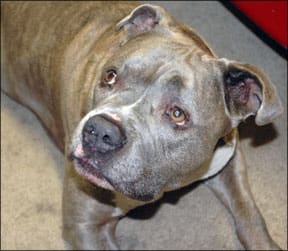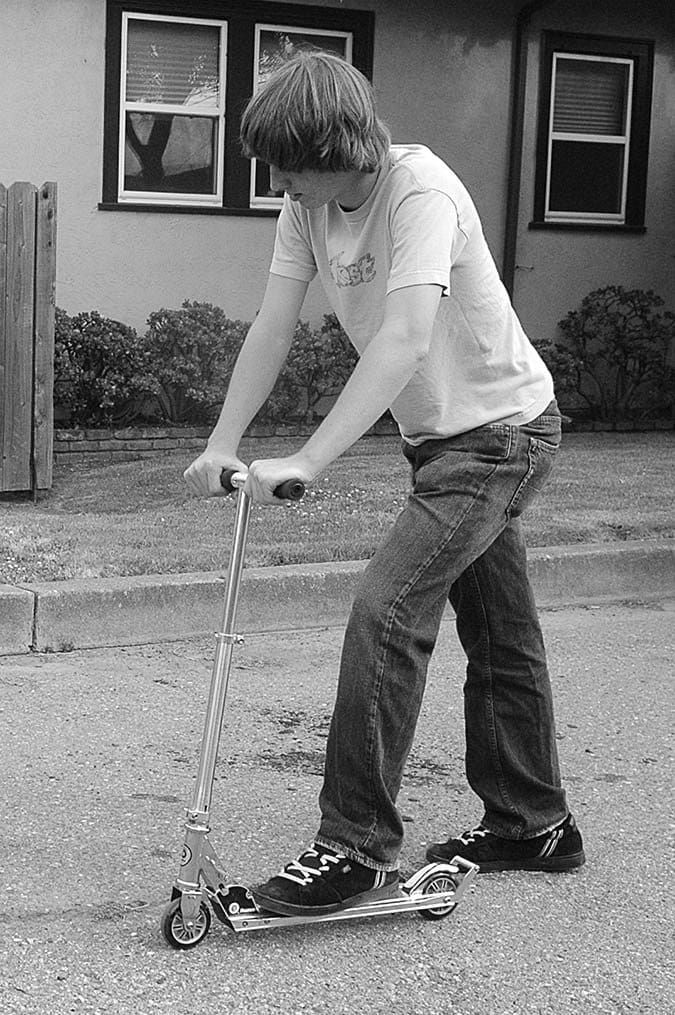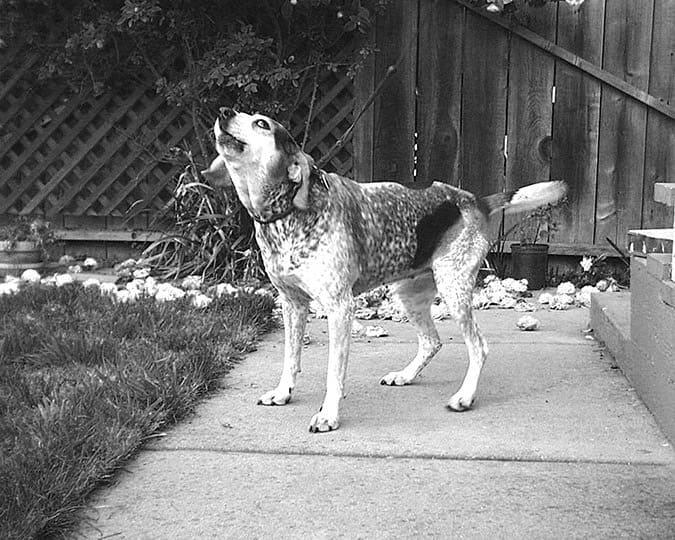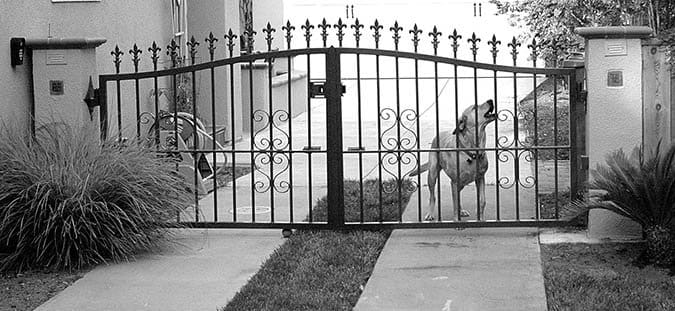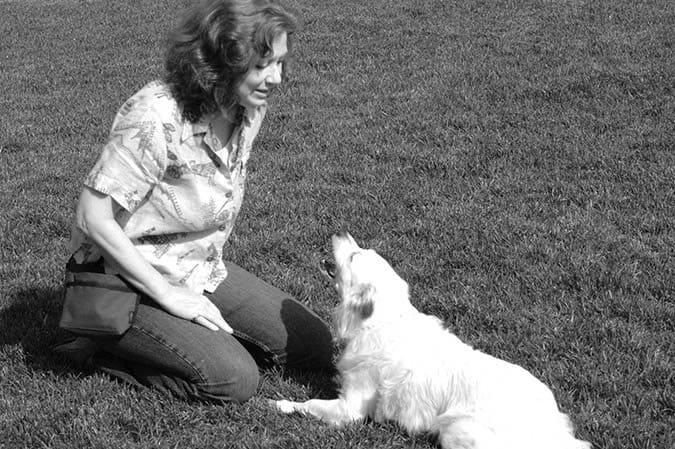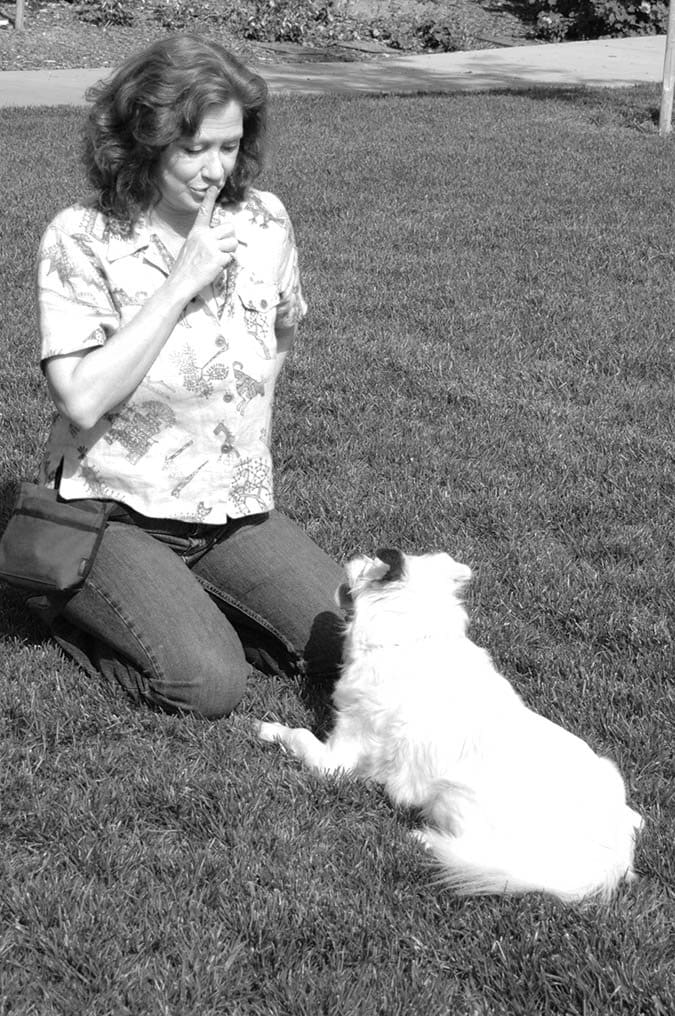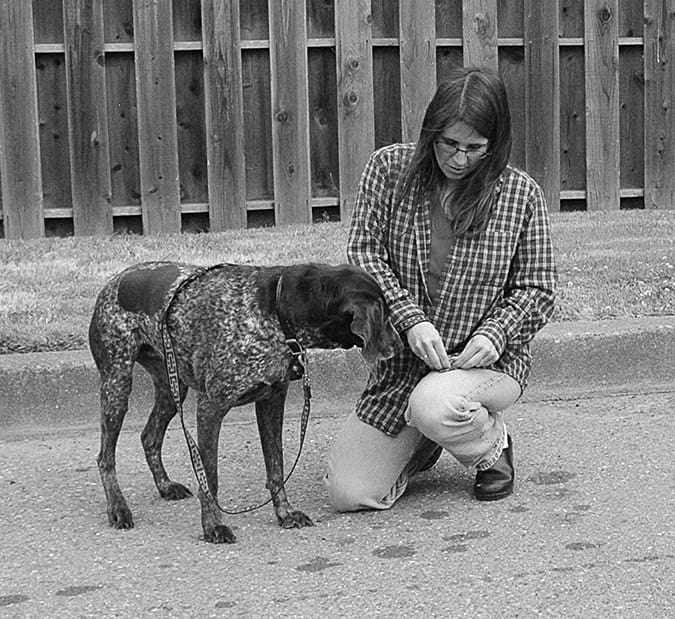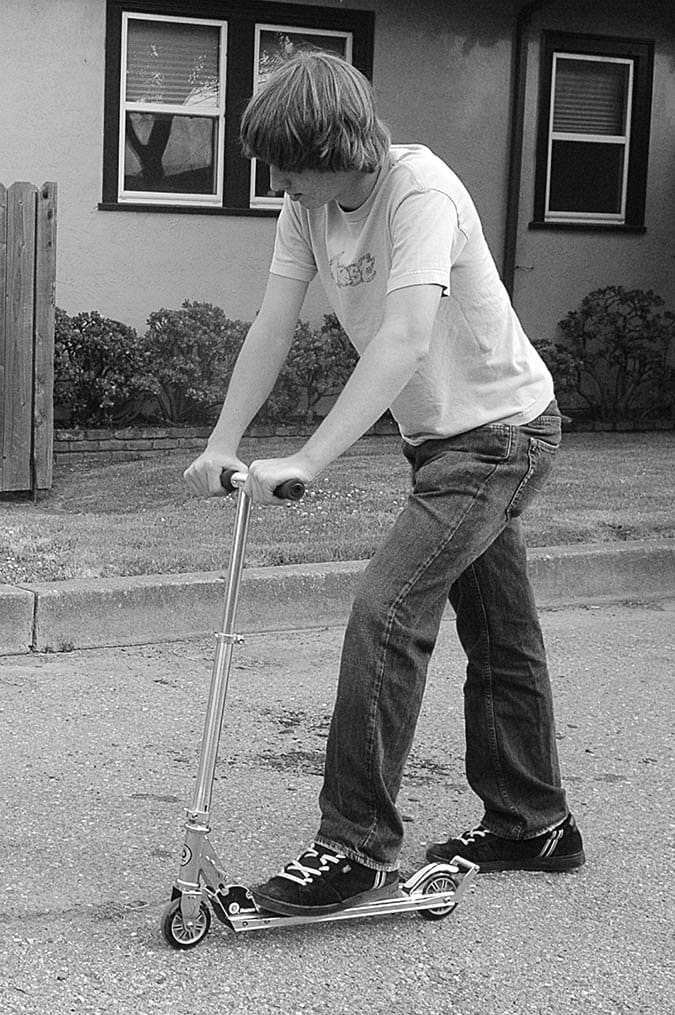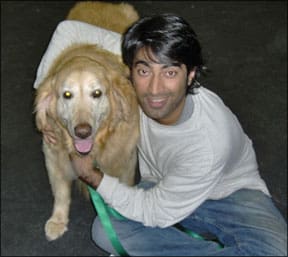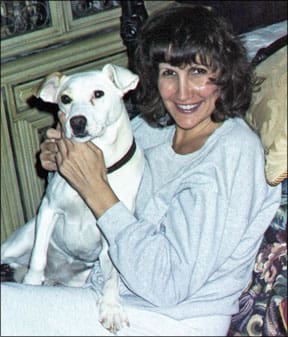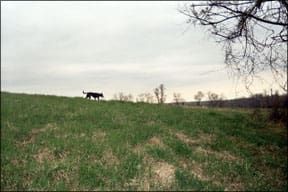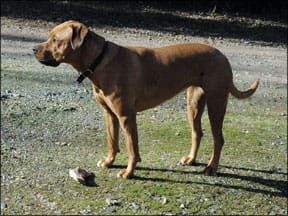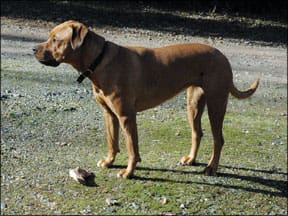Bees may sting, but they create some of the world’s most valuable, versatile products. Honey, bee pollen, royal jelly, beeswax, propolis, and even the venom from bee stings are all touted for their human health benefits – and many experts say that dogs derive the same advantages.
Feeding honey to dogs is nothing new. Juliette de Bairacli Levy, whose Natural Rearing philosophy has offered alternatives to conventional treatment for over 60 years, recommends honey in all of her animal care books.
“I believe I could not successfully rear domestic dogs without this remarkable antiseptic food,” she says in The Complete Herbal Handbook for the Dog and Cat. She adds that while honey is not a normal item of diet for carnivores, lions in the wild enjoy honey and it is considered a staple food of the omnivorous bear.

“Honey is the greatest of the natural energizers,” Levy writes, “a nerve tonic and a supreme heart tonic . . . Predigested by its makers, the bees, it is absorbed immediately into the bloodstream of the consumer. A diet of only milk and honey can sustain life for months in humans and animals. It has been well and longtime proved that honey is also highly medicinal and will inhibit growth of harmful bacteria in the entire digestive tract and destroy those of a toxic nature.”
Levy recommends fasting animals who are ill to let their digestive organs rest and the body to heal quickly. In addition to water, the only food she recommends for fasting animals is honey.
An invert sugar, honey contains mostly glucose and fructose, which are monosaccharides or simple sugars. Monosaccharides are more easily assimilated than the disaccharides and polysaccharides found in table sugar, milk, grains, legumes, and starchy vegetables. A tablespoon of honey supplies 63 calories. Honey does not require refrigeration but keeps best in tightly sealed containers stored away from heat and light. Honey thickens when refrigerated.
Depending on the flowers harvested by the bees, honey is light or dark in color, and its flavors vary from delicate to complex. Raw honey contains vitamins A, B-complex, C, D, E, and K, plus calcium, phosphorus, magnesium, silicon, sulfur, potassium, manganese, copper, and iodine, with darker varieties such as buckwheat containing higher mineral levels. Vitamin C levels vary; some honey contains up to 300 milligrams of vitamin C per 100 grams (about 3½ ounces or 7 tablespoons).
Honey has been a medicine as well as a food for millennia. Ancient Greek, Assyrian, Chinese, and Roman physicians routinely prescribed it for health and longevity and for conditions such as indigestion, diarrhea, fevers, coughs, colds, flu, asthma, allergies, and ulcers, and as a revitalizing food for athletes, soldiers, and those recovering from illness or injury. Honey is said to increase the absorption of calcium consumed at the same time, help treat or prevent anemia, reduce arthritis pain, and work as a gentle laxative to help prevent constipation. It was also applied topically to treat open wounds, burns, cuts, abrasions, and skin infections.
Honey for Dogs
Most dogs love the taste of honey, so it’s usually easy to feed. Some dogs eat it right off the spoon, some get it in their dinner, and quite a few enjoy their daily honey on toast with butter. In Denison, Texas, 50 miles north of Dallas, beekeeper and companion dog trainer Michele Crouse considers honey the best medicine for her dogs Bonnie, a four-year-old Staffordshire Terrier, and Cracker, a five-year-old yellow Labrador Retriever.
“Bonnie has always had a hard time with allergies,” Crouse says. “Her symptoms used to be worst in the spring and early summer, but they continued through the fall ragweed season. She rubbed her face, licked herself, especially on her feet and the inside of her thighs, and scratched on her stomach like crazy, creating dime-sized sores. She itched so much that the vet prescribed Benadryl and prednisone.”
To prevent these attacks, Crouse feeds her dogs a tablespoon of honey twice a day. “I mix it with their food or feed it directly,” she says. “Sometimes I’ll give them berries as a snack, with the honey mixed in. Both Bonnie and Cracker love the taste. Otis, our mixed-breed, isn’t interested in honey or anything sweet. Fortunately, he doesn’t have allergy symptoms.”
Crouse uses raw honey which she strains through a single filter to remove debris. “Otherwise,” she says, “it’s straight out of the hive.”
As long as Bonnie receives her daily honey, she remains free of allergy symptoms. “But if I forget for a week or so,” says Crouse, “the symptoms come right back. I know several other dogs who have had the same response. They react to seasonal allergens until their owners put them on honey, and then they’re fine.”
Crouse agrees with beekeepers and health experts who have observed that local raw honey works best on allergy symptoms. “It makes sense,” she explains. “When you eat the honey, you ingest minute amounts of local pollen, and after your body adjusts so that it doesn’t react to the pollen, you can be exposed to larger amounts, such as when plants or trees are in bloom, without being affected.”
In addition to using honey as a food, Crouse washes her dogs with it. “I start with a clear, natural shampoo base from an organic supplier,” she says, “and mix it with an equal amount of honey to which I’ve added aloe vera and essential oils like lemon grass, orange, lemon, lavender, tea tree, citronella, and the Asian herb May Chang (Litsea cubeba). All of these plants have disinfecting, deodorizing, or insect-repelling properties. The essential oils make up about 5 percent of the formula, so it’s safe for adult dogs and older puppies. To dilute the shampoo and make it easier to use, I add about 25 percent water.”
Crouse says that the resulting shampoo doesn’t lather much, but it cleans the dog well and soothes the skin. “I let it stand for a minute or so, rinse it off, reapply, and then give a final rinse. I board dogs, and if a visiting dog is scratching and itching, I’ll give him a bath in honey shampoo, and that always helps.” In Jacksonville, Oregon, Natural Rearing consultant Marina Zacharias feeds her dogs honey and applies it topically to cuts and wounds.
“The high sugar content of honey is one of the factors that makes it such an excellent infection fighter and wound healer,” says Zacharias. “Glucose oxidase, an enzyme in honey, produces hydrogen peroxide, which helps kill harmful bacteria. In addition, there are yet-unidentified substances which bees collect from flowers that give their honey antibacterial properties. For best results, it’s important to use raw honey that hasn’t had its effectiveness destroyed by processing.”
Clinical trials of burn and injury patients show that the application of honey as a wound dressing rapidly clears infection, inflammation, swelling, pain, and odor while speeding the sloughing off of necrotic tissue (dead skin) and the growth of new skin cells. It remains moist, seals wounds – including skin grafts – and protects them from exposure to air, absorbs pus, reduces scarring, and prevents wounds from sticking to bandages. Unlike other topical antiseptics, honey prevents microbial growth without causing tissue damage.
Raw honey eventually crystallizes or solidifies, making it difficult to apply. In addition, honey crystals can feel sharp on tender or inflamed skin. For best results, apply soft or liquid honey. To liquify crystallized honey, stand the jar in hot water until it can be stirred or poured. Microwaving is not recommended because in addition to destroying enzymes and other nutrients, heating honey in a microwave increases its hydroxymethylfurfural (HMF) content, which adversely affects its flavor.
In addition to applying honey to wounds, Zacharias has successfully treated wart-like growths with honey. “When honey is applied daily, they eventually soften and disappear,” she says. “Juliette recommends honey as a treatment for burns. I have personally seen this work, and the healing is remarkable. In one case, a young mixed-breed toy dog tripped his owner and the scalding hot coffee she was carrying burned his back. The skin did not blister but it was very painful and angry looking. Thanks to honey, the dog healed very well, and his hair grew back beautifully.”
The procedure Zacharias recommends is to wash the burned area with vinegar and apply honey thickly every 10 minutes until the pain subsides, then apply light bandages over the area. “Unfortunately, the hair will need to be clipped away,” she says, “and if the dog wants to bother the bandage, you will need to use an Elizabethan or cervical collar.”
On other wounds, Zacharias says, you can apply honey directly without bandaging. If the dog wants to lick it off, try distracting him for 20 minutes or so and give the honey time to be absorbed by the skin. You can reapply it this way three or four times a day.
“Honey applied twice a day healed an open cyst that wouldn’t close in one of my older Basset Hounds, Savannah. As soon as I started applying honey, her skin closed over the wound, it healed fast, and we avoided surgery.”
Herbal Honey for Dogs
Most dogs enjoy the taste of honey, which simplifies the administration of fresh or dried medicinal herbs. “Canine Allergies and Your Dog’s Health” (May 2007) described how the herb cleavers (Galium aparine) helped cured a dog’s allergy-related sores on its legs. Several readers who began feeding their dogs cleavers tea reported that the strategy worked for them as well. Brewing tea is one way to add cleavers to your dog’s diet, but another is to make an herbal honey.
Start by coarsely chopping enough fresh lemon balm, thyme, sage, oregano, lavender, basil, or other herbs to loosely fill a glass jar. Alternatively, fill the jar half full with loosely packed dried herbs. Fill the jar with honey, covering the herbs. If the honey is too thick to pour easily, warm it by placing the honey jar in hot water or heat the honey gently in a saucepan or double boiler just until it is liquid.
Seal the jar of herbs and honey and leave it in a warm location, such as a sunny window, for at least two weeks. For a double-strength herbal honey, wait a month or more, then fill another glass jar with herbs, pour the contents of the first jar into the second jar, and let the honey stand another month. If you’re in a hurry, heat the honey until it’s almost boiling and the pour it over the herbs. The honey won’t be raw any more, but it will still contain significant healing properties, and it can be strained and used the same day.
Before using herbal honey, filter it through cheesecloth or a strainer to remove plant material and store it at room temperature or in the refrigerator. Add the medicated honey to your dog’s food. In addition, keep a small jar of honey (herbal or plain) in your first-aid kit or backpack for use in emergencies.
Honey infused with the herbs mentioned above is an effective dressing for cuts, surgical wounds, burns, lick granulomas, abrasions, hot spots, and infected wounds. It can be given orally to prevent infection from viruses or bacteria, soothe a sore throat, help an anxious dog relax, improve sleep, and speed recovery from illness. Added to food, herbal honey helps reduce gas and other symptoms of indigestion.
Another way to feed herbs is to mix them with thick raw honey (refrigerate honey for a thicker consistency if necessary) and shape it into small balls that are easy for the dog to swallow. Use the same technique you would to pill a dog.
All honey, especially organic raw honey, has medicinal benefits, but the honey best known for its antimicrobial properties is manuka honey from New Zealand. More than 20 years of research have shown it to naturally destroy harmful bacteria such as Staphaureus and Streptococcus (including drug-resistant strains); Helicobacter pylori bacteria associated with stomach ulcers; vancomycin-resistant Enterococci; and Pseudomonas. The veterinary use of manuka honey includes its application as a dressing for burns, amputations, and wounds, and its internal use for gastrointestinal and digestive problems.
Can honey be given to dogs with diabetes? Experts disagree as to whether honey has all of white sugar’s harmful effects or has a slower blood sugar absorption rate, putting it lower on the glycemic index and making it less likely to disrupt the patient’s blood sugar levels. Some tests have shown honey to cause a significantly lower rise in blood sugar, but results vary according to the type of honey used. Discuss this with your holistic veterinarian.
Also, consider feeding dark raw local honey or raw organic honey. The safest way to feed a therapeutic tablespoon once or twice a day to dogs with diabetes is to start with smaller amounts and always feed it in combination with fats, which by itself lowers a food’s glycemic index. Coconut oil and butter are excellent honey partners. Observe your dog’s reaction before increasing the amount and discontinue use if he displays any adverse symptoms.
Bee Pollen for Dogs
As they collect nectar from flower blossoms, bees also gather pollen, a high-protein food, to carry back to the hive. While doing so, they spread pollen from flower to flower, fertilizing plants so that they produce berries, fruits, nuts, and vegetables. More than 100 crops grown in the US are pollinated by honeybees.
Bee pollen, which is collected from hives and sold as a health supplement, has long been prized for its proteins, amino acids, vitamins, enzymes, and other nutrients. Approximately half of its protein is made up of free-form amino acids, which require no digestion; they are immediately absorbed and utilized by the body. It is unusually high in the bioflavonoid rutin, which strengthens capillaries, protects against free radical damage and has anti-inflammatory effects.
Proponents claim that bee pollen improves energy, endurance, and vitality, speeds recovery from illness or injury, helps convalescents gain weight, helps the overweight lose weight, reduces cravings and addictions, fights infectious diseases, boosts immunity, improves intestinal function, increases fertility, and helps prevent cancer.
Bee pollen is also a widely used remedy for hay fever and allergies. As with raw honey, which contains small amounts of bee pollen, it is said to be most effective when derived from local hives and taken for several weeks prior to allergy season, then continued through the year. This desensitization process begins with tiny amounts, such as a single pollen grain or pellet, and continues in gradually increasing amounts until the maintenance dose, as much as a tablespoon per day for human adults, is reached.
Some canine athletes are fed bee pollen to improve their strength and stamina; some owners give it to their dogs as an all-purpose supplement or to prevent allergy symptoms. For best results, avoid inexpensive imported heat-processed pollen in favor of raw, unprocessed pollen from local beekeepers. Fresh bee pollen is slightly moist and requires refrigeration.
Like people, dogs can have allergic reactions to bee pollen, including wheezing, breathing problems, and even anaphylactic shock. Start with a single grain of bee pollen and carefully check your dog’s response. If he shows no symptoms of discomfort, give two grains the next day, and slowly increase the amount over several weeks to a maintenance dose of 1 teaspoon per 30 pounds of body weight per day, mixed with food. Bee pollen is often blended with honey.
Using Royal Jelly on Dogs
To appreciate the nutritional value of royal jelly – for bees, at least – consider that all queen bees begin life as worker bees. It is only because they are fed royal jelly and nothing else that they grow larger than worker bees and live far longer. While the average worker bee lives for five to six weeks during summer, queens live for three to six years, laying 2,000 eggs per day.
The queen bee’s longevity and fertility gave rise to royal jelly’s reputation as a miraculous rejuvenator, fountain of youth, and energy enhancer. Modern researchers have substantiated at least some of these claims, describing royal jelly as a metabolic catalyst, a substance that combats fatigue, increases energy, and supports the adrenal glands. Some of royal jelly’s components are natural antidepressants.
Royal jelly has become a popular supplement for humans and for some canine athletes and breeding dogs. Organic royal jelly is available in natural foods markets. Highly perishable, it requires refrigeration. Most labels recommend taking small amounts, such as ¼ to ½ teaspoon once or twice per day between meals on an empty stomach. Adjust the label dose for your dog’s weight, dividing it in half for dogs weighing 60 to 80 pounds.
Because of its slightly sharp, bitter, biting taste, dogs may not care for royal jelly. Blends of royal jelly and honey, which are also popular, may be more to their liking. Try mixing your own by blending 2 ounces (4 tablespoons) organic royal jelly with 6 ounces (¾ cup) of local raw honey. Keep refrigerated. Give your dog ½ to 1 teaspoon of this blend twice per day, morning and night.
Some manufacturers of human and canine grooming products add royal jelly to their shampoos and conditioners, claiming that it enhances hair color and increases volume. Those claims have not been scientifically tested, but royal jelly is certainly a luxury ingredient.
Propolis for Dogs
Few substances are as antiseptic as propolis, a sticky, resinous material also known as “bee glue,” which is gathered from the buds, bark, and leaves of deciduous trees. Bees seal cracks and holes in their hives with propolis to prevent the entrance of intruders and to disinfect or sterilize bees brushing against it. When a mouse or other invader is stung to death in the hive, bees seal the body in propolis, preserving it while keeping the inside of the hive sanitary.
Although propolis has been used for millennia to fight infection and improve health, it is unfamiliar to most Americans. However, it’s gaining popularity as a natural antibiotic that doesn’t disrupt beneficial bacteria or cause other side effects. Propolis, which is rich in bioflavonoids, is effective against viruses, harmful bacteria, yeasts, and fungi. It also has anti-inflammatory properties, helps prevent allergies, and speeds the healing of ulcers and skin problems such as acne, eczema, wounds, cuts, and burns.
The only down side of propolis, especially when it comes to treating dogs, is its awful taste. Freeze-dried propolis is sold in capsules, which can be hidden in food, and small amounts of propolis tincture (liquid extract) can be placed in empty two-part gel caps, which are sold in health food stores, just before using.
Propolis tincture can help protect dogs from canine flu, kennel cough, and other infectious illnesses. It can be applied to cuts, wounds, burns, bites, stings, hot spots, and lick granulomas (its bitter taste helps deter licking). However, its stickiness can complicate topical application. Mix propolis with a small amount of olive oil to create a less sticky disinfecting salve. Mix it with honey to help heal gum disorders.
Beeswax for Dogs
Bees produce wax to construct the combs that store honey. Beeswax contains more than 300 different chemicals. It’s best known for its use in candles and as an ingredient in cosmetics, floor wax, furniture polish, and salves.
The makers of herbal salves often use beeswax as a thickener. Michele Crouse makes body bars by combining beeswax from her hives with coconut oil, avocado oil, cocoa butter, and mango butter. “They’re the consistency of a ChapStick,” she says, “and they do a great job of healing sores, moisturizing dry skin, and soothing cracked paw pads.”
Bee Venom
Some people pay to get stung by bees or injected with bee venom in medical clinics. Apitherapy, or bee sting therapy, is common in China and gaining popularity in Europe and the US. It is said to alleviate arthritis, other symptoms of inflammation, and allergic reactions to bee stings.
Now dried bee venom is being added to some New Zealand honeys and topical creams to provide the benefits of apitherapy without the pain. The theory is that venom that is ingested or applied externally has the same health benefits as venom that’s injected.
Large-scale venom collection is made possible by a technology developed in Russia and New Zealand in which a bee venom frame is mounted on top of a hive’s honey frame. Bees receive a mild shock from the frame’s electro-stimulator and in response sting a glass collection sheet. Venom dries on the glass, which is taken to a nearby laboratory for processing. The dried venom is removed from the glass and mixed with honey or used in other bee products.
Arthritis is the human condition for which bee venom honey is said to be most effective, but bee venom honey success stories include the treatment of auto-immune disorders, shingles, tennis elbow, bursitis, lower back pain, ligament injuries, premenstrual syndrome, and other conditions. Bee venom honey is said to support the body’s natural coritsol levels, increase blood flow through affected joints, and inhibit the production of prostaglandins, which are chemicals that increase inflammation.
New Zealand honey producers have received testimonials describing dogs whose arthritis, hind end weakness, torn ligaments, and even hip dysplasia improved as a result of using bee venom honey.
Bees Are in Serious Danger…
For the past two decades, Juliette de Bairacli Levy has asked her followers not to use honey or other products from honeybees because these helpful insects are under so much environmental stress. Between pesticides, mite infestations, foulbrood disease, hive-damaging moths, and other problems, bee populations have dramatically fallen across North America. Now Colony Collapse Disorder is destroying entire hives. Bees look healthy one day and disappear the next, becoming too weak to return to their hives. In most cases, the victims have been raised for commercial crop pollination, given supplemental feedings containing white sugar, and exposed to chemical pesticides.
At the same time, organic beekeepers and beekeepers who feed their bees disinfecting essential oils report that their hives stay healthy even in areas where Colony Collapse Disorder has become common.
In her many years as a beekeeper, Levy prevented bee diseases by growing disinfecting herbs near her hives. “The bees themselves are natural herbalists,” she wrote, “and will gorge themselves on bitter rue or pungent lavender and rosemary. My bees enjoyed excellent health and possessed complete resistance to the many diseases afflicting the local white-sugar-fed bees.”
Local organic honey, if you can find it, can be an excellent addition to your dog’s diet and health care. A good second choice is organic honey from nearby states.
CJ Puotinen is author of The Encyclopedia of Natural Pet Care, Natural Remedies for Dogs and Cats, and other books. She lives in New York with her husband, a Labrador, and a tabby cat.





